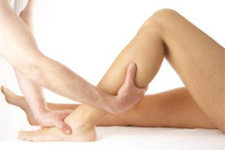Sore Calf Muscles

Bothered By Sore Calf Muscles? Here's Why
Sore calf muscles are not all that uncommon. Most of us experience them at one time or another, especially people who are physically quite active. Even though the calf muscles may have become strengthens and well-toned through a program of exercise and stretching, it is still not uncommon to occasionally stress the muscles beyond their limit. The net result is usually a mild form of soreness which goes away in a day or two, if not sooner.
What The Calf Muscle Does - The calf muscle is a very large muscle, located on the back of our lower leg. It is connected to the heel bone by the Achilles tendon, and its primary function is to flex and point the toes. This might seem like a strange, and somewhat unimportant task for such a large muscle. The calf muscle however helps us to maintain our balance when running, jumping, or pushing using our legs. If you climb a ladder using the balls of your feet or your toes for support, you'll soon find out why the calf muscles need to be as powerful as they are.
Climbing up and down a ladder for an extended period of time, especially if you're not used to doing it, is an excellent way to develop a pair of sore calf muscles. The muscles are being stretched a great deal more than is normally the case when one is walking, or even running. If they are not used to that degree of stretching, or are not properly warmed up, small, almost microscopic tears, will occur in the muscle, later resulting in muscle soreness.
High Heels To Running Shoes – A Potential Problem - Women who wear high heels most of the day are more susceptible to sore calf muscles than the average person. Constantly wearing high heels compresses the calf muscles. For a muscle to be kept in good tone, it needs to be stretched, rather than compressed (actually it needs both). When a lady steps out of her high heels and takes up jogging for the first time, sore calf muscles are almost guaranteed to be a result. The muscles are not used to being stretched, as they will be when jogging or running, and will complain.
Degrees Of Injury - Most of the time when we have sore calf muscles, it’s a rather mild case and a day's rest is often all that's needed. Slightly more severe would be what is called a grade 1 calf strain. This is a more severe case of stretching where minor damage to the calf muscle or muscles has occurred, and it may take up to two weeks for the muscle to heal and the pain to go away. More severe cases would involve actual tearing or rupture of the muscle fibers and many weeks of treatment and therapy may be required. In such an event we are no longer talking about sore calf muscles but some real serious pain.
Two Effective Exercises - There are a couple of easy calf stretching exercises one can do to keep sore calf muscles to a minimum. One is the runner's stretch. Stand 2 to 3 feet from a wall or railing. Place one foot in front of the other. The front knee is bent, the back leg straight. Push against the wall, keeping the heel of the back leg pushed into the ground or floor, stretching the muscle. Don't bounce, but hold the stretch for 30 seconds or more. Repeat with the other leg.
For second exercise, a wall, or even the back of a chair is used for balance, standing on both feet, raise up on your toes. Hold the position, and then lower your feet and, with your weight on your heels, lift up your toes (this is where you need something for balance). Repeat the alternating heels-up, toes-up routine for 12 to 15 repetitions. Do it slowly and get a good stretch each time.
A good practice is to do these exercises, especially the runner’s stretch, any time before jogging, running, playing tennis, or any strenuous physical activity involving the leg muscles. Sore calf muscles can't always be avoided entirely, but the soreness can be kept within easily tolerable limits.